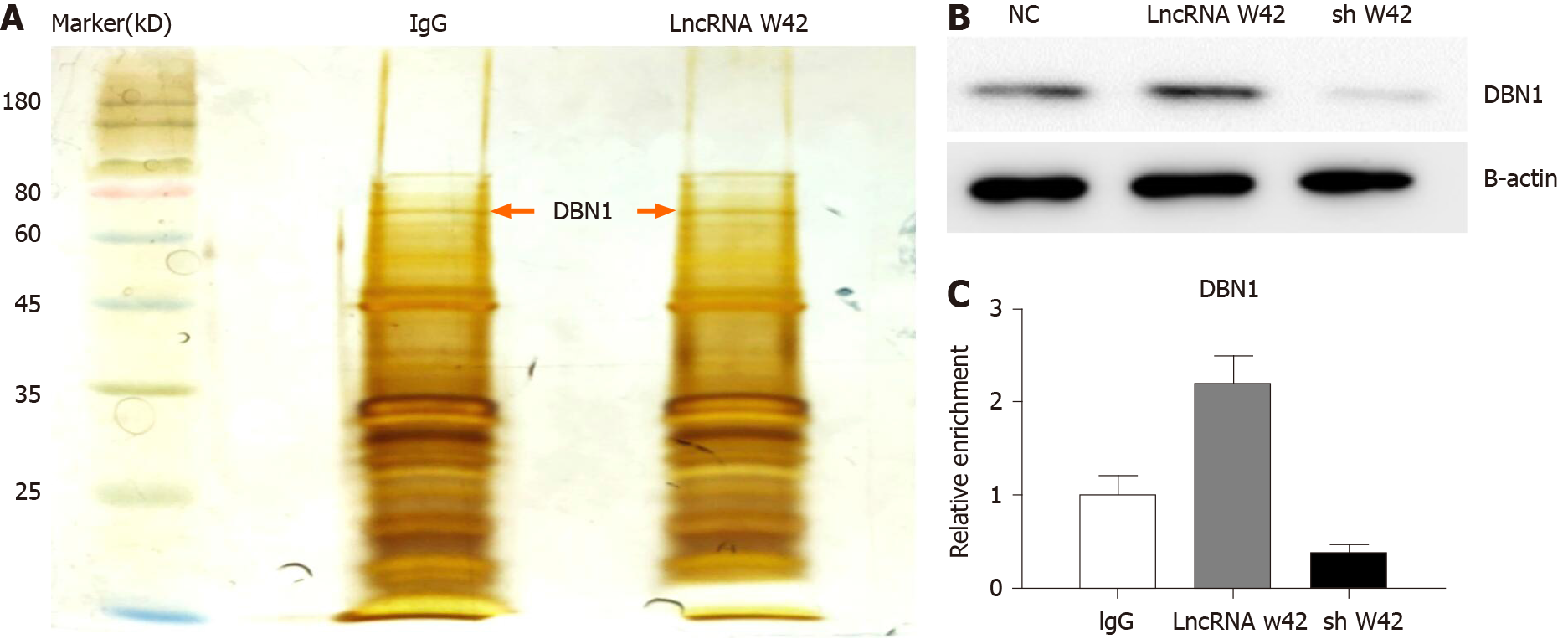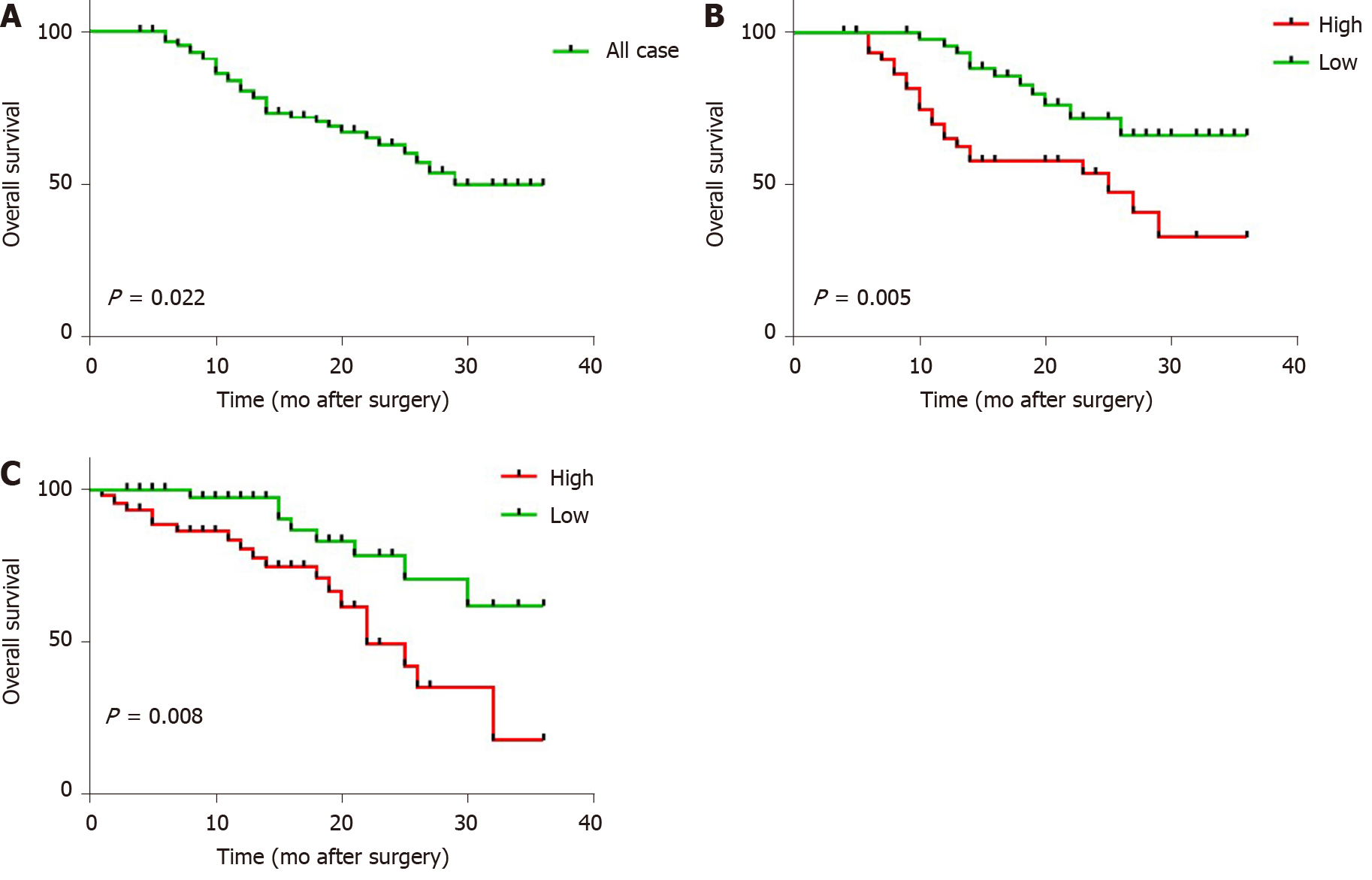Copyright
©The Author(s) 2021.
World J Gastroenterol. May 28, 2021; 27(20): 2586-2602
Published online May 28, 2021. doi: 10.3748/wjg.v27.i20.2586
Published online May 28, 2021. doi: 10.3748/wjg.v27.i20.2586
Figure 1 The levels of long noncoding RNA W42 expression in human hepatocellular carcinoma tissues and cell lines.
A: Relative expression levels of long noncoding RNA (lncRNA) W42 in human hepatocellular carcinoma (HCC) tissue compared to paired adjacent noncancerous tissues (n = 92). LncRNA W42 expression was examined by quantitative reverse transcriptase polymerase chain reaction and normalized to GAPDH (glyceraldehyde-3-phosphate dehydrogenase) expression (cP < 0.001); B: The level of lncRNA W42 expression was higher in HCC cell lines than in the normal liver cell line LO2 (cP < 0.001); C: The area under the receiver operating characteristic curve was used for prediction of HCC based on lncRNA W42 expression, using paired adjacent noncancerous tissues as a control; D: Quantitative reverse transcriptase polymerase chain reaction analysis of lncRNA W42 in subcellular fractions of SMMC 7721 and Huh7 cells. β-Actin and U6 acted as cytoplasmic and nuclear markers, respectively (n = 3). ROC: Receiver operating characteristic.
Figure 2 Long noncoding RNA W42 affects proliferation and invasion in hepatocellular carcinoma cells in vitro.
A: Long noncoding RNA (lncRNA) W42 knockdown in SMMC 7721 and Huh7 cells. The expression level of lncRNA W42 was robustly enhanced or inhibited when cell lines were infected with lentivirus containing the lncRNA W42 coding sequence or two shRNAs targeting lncRNA W42, respectively. Empty vector and shRNA control were used as the negative controls; B: CCK-8 assays were used to determine the viability of SMMC7721 and Huh7 cells transfected with shRNA-lncRNA W42. The cell number was examined from 24 h to 96 h. The results are shown as the mean ± SE. aP < 0.05, compared with the control by two-sided t test; C: Colony forming assays were performed to determine the proliferation of SMMC7721 and Huh7 cells transfected with shRNA-lncRNA W42; D: Transwell assays to measure the impact of lncRNA W42 knockdown on HCC migration ability; E: Annexin V-fluorescein isothiocyanate/propidium iodide assay for the effect of overexpression or knockdown of lncRNA W42 on early apoptosis of HCC cell lines. aP < 0.05, bP < 0.01, cP < 0.001. LncRNA: Long noncoding RNA.
Figure 3 Long noncoding RNA W42 directly bound to DBN1 and enhanced DBN1-mediated tumor-promoting effects.
A: RNA pull-down of AVAN-associated proteins using biotinylated long noncoding RNA (lncRNA) W42 or antisense probes (immunoglobulin G, IgG). Isolated proteins were resolved by SDS-PAGE (sodium dodecyl sulfate-polyacrylamide gel electrophoresis) followed by silver staining; B: Pull-down western blot showing that lncRNA W42 can bind directly to DBN1; C: RNA immunoprecipitation of DBN1 in SMMC7721 cells using anti-DBN1 or anti-IgG antibodies. The relative fold enrichment of lncRNA W42 was calculated by quantitative reverse transcriptase polymerase chain reaction. IgG: Immunoglobulin G; LncRNA: Long noncoding RNA; NC: Negative control.
Figure 4 Effects of long noncoding RNA W42 expression on tumor growth in hepatocellular carcinoma nude mouse model.
A: SMMC7721 cells (5 × 106) stably expressing long noncoding RNA (lncRNA) W42 were inoculated into hepatocellular carcinoma (HCC) nude mice, and the effect of lncRNA W42 on HCC tumor growth was examined every 3 d for 36 d (n = 8). Thirty-six days after injection, tumors were dissected from the mice in the lncRNA W42 knockdown and control groups. Representative images are shown; B: The growth rate of tumors in the lncRNA W42 knockdown group was lower than that in the control group. mean ± SE for eight mice in each group. cP < 0.001 compared with the control group; C: The weights of tumors dissected from mice in the lncRNA W42 knockdown group were significantly lower than those of their control counterparts. The results are shown as the mean ± SE for eight mice in each group. bP < 0.01 compared with control cells by two-sided t test. LncRNA: Long noncoding RNA.
Figure 5 Association between long noncoding RNA W42 expression and hepatocellular carcinoma patient survival rates as determined by Kaplan-Meier analyses.
A: The three-year overall survival rate of 92 hepatocellular carcinoma (HCC) patients was 64.13%; B: Patients with HCC with high long noncoding RNA (lncRNA) W42 expression levels showed significantly shorter overall survival than those with low lncRNA W42 expression levels (P = 0.005, log-rank test); C: Patients with HCC with high lncRNA W42 expression levels showed significantly shorter recurrence-free survival than those with low lncRNA W42 expression levels (P = 0.008, log-rank test).
- Citation: Lei GL, Niu Y, Cheng SJ, Li YY, Bai ZF, Yu LX, Hong ZX, Liu H, Liu HH, Yan J, Gao Y, Zhang SG, Chen Z, Li RS, Yang PH. Upregulation of long noncoding RNA W42 promotes tumor development by binding with DBN1 in hepatocellular carcinoma. World J Gastroenterol 2021; 27(20): 2586-2602
- URL: https://www.wjgnet.com/1007-9327/full/v27/i20/2586.htm
- DOI: https://dx.doi.org/10.3748/wjg.v27.i20.2586













